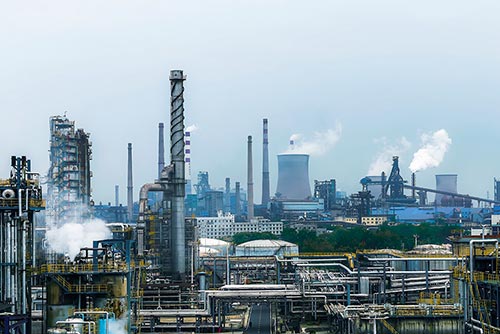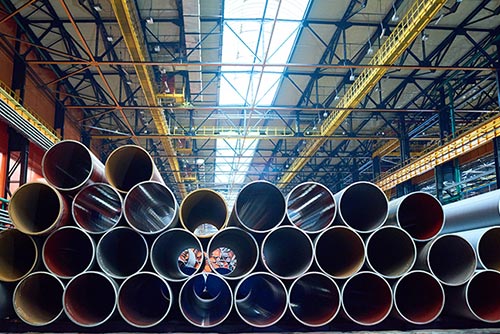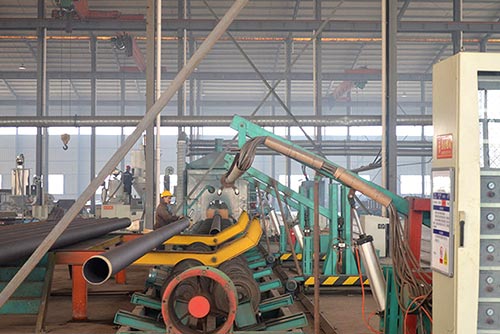ASTM A333/A333M低温和其他应用中具有所需缺口韧性的无缝和焊接钢管标准规范。
- 分类:国外产品技术与服务
- 作者:www.negerekli.com中燃管道
- 来源:英国ladbrokes官方网站
- 发布时间:2024-09-24
- 访问量:533
【概要描述】ASTM A333/A333M规范涵盖了低温下使用的壁无缝和焊接碳和合金钢管。管道应采用无缝或焊接工艺制造,焊接操作中不添加填充金属。
ASTM A333/A333M低温和其他应用中具有所需缺口韧性的无缝和焊接钢管标准规范。
【概要描述】ASTM A333/A333M规范涵盖了低温下使用的壁无缝和焊接碳和合金钢管。管道应采用无缝或焊接工艺制造,焊接操作中不添加填充金属。
- 分类:国外产品技术与服务
- 作者:www.negerekli.com中燃管道
- 来源:英国ladbrokes官方网站
- 发布时间:2024-09-24
- 访问量:533
ASTM A333/A333M
ASTM A333/A333M Standard Specification for Seamless and Welded Steel Pipe for Low-Temperature Service and Other Applications with Required Notch Toughness. ASTM A333/A333M低温和其他应用中具有所需缺口韧性的无缝和焊接钢管标准规范。
ASTM A333/A333M specification covers wall seamless and welded carbon and alloy steel pipe intended for use at low temperatures. The pipe shall be made by the seamless or welding process with the addition of no filler metal in the welding operation. All seamless and welded pipes shall be treated to control their microstructure. Tensile tests, impact tests, hydrostatic tests, and nondestructive electric tests shall be made in accordance to specified requirements.
ASTM A333/A333M规范涵盖了低温下使用的壁无缝和焊接碳和合金钢管。管道应采用无缝或焊接工艺制造,焊接操作中不添加填充金属。所有无缝管和焊接管应进行处理,以控制其微观结构。应按照规定要求进行拉伸试验、冲击试验、静水压试验和无损电气试验。
What is ASTM A333 standard? ASTM A333标准是什么?
ASTM A333 is the standard specification for seamless and welded carbon and alloy steel pipe for low temperature service or other applications requiring notch toughness.
ASTM A333是用于低温服务或其他需要缺口韧性的应用的无缝和焊接碳和合金钢管的标准规范。
Scope范围
Several grades of ferritic steel are included. Some product sizes may not be available under this specification because heavier wall thicknesses have an adverse affect on low-temperature impact properties. The pipe shall be made by the seamless or welding process with the addition of no filler metal in the welding operation. All seamless and welded pipes shall be treated to control their microstructure. Tensile tests, impact tests, hydrostatic tests, and nondestructive electric tests shall be made in accordance to specified requirements.
包括几种等级的铁素体钢。根据本规范,某些产品尺寸可能不可用,因为较厚的壁厚会对低温冲击性能产生不利影响。管道应采用无缝或焊接工艺制造,焊接操作中不添加填充金属。所有无缝管和焊接管应进行处理,以控制其微观结构。应按照规定要求进行拉伸试验、冲击试验、静水压试验和无损电气试验。
ASTM A333 alloy pipe shall be made by the seamless or welding process with the addition of no filler metal in the welding operation. All seamless and welded pipes shall be treated to control their microstructure. Tensile tests, impact tests, hydrostatic tests, and nondestructive electric tests shall be made in accordance to specified requirements. Some product sizes may not be available under this specification because heavier wall thicknesses have an adverse affect on low-temperature impact properties.
ASTM A333合金管应采用无缝或焊接工艺制造,焊接操作中不添加填充金属。所有无缝管和焊接管应进行处理,以控制其微观结构。应按照规定要求进行拉伸试验、冲击试验、静水压试验和无损电气试验。根据本规范,某些产品尺寸可能不可用,因为较厚的壁厚会对低温冲击性能产生不利影响。
ASTM A333 steel pipe production includes a series of visual surface imperfections to guarantee that they have been properly manufactured. ASTM A333 steel pipe shall be subject to rejection if surface imperfections acceptable are not scattered, but appear over a large area in excess of what is considered a workmanlike finish. The finished pipe shall be reasonably straight.
ASTM A333钢管生产包括一系列可见的表面缺陷,以确保其得到正确制造。如果可接受的表面缺陷不是分散的,而是出现在大面积上,超过了被认为是熟练的表面处理,则ASTM A333钢管应被拒收。成品管道应合理笔直。
Surface inspection requirements表面检查要求
Surface imperfections that penetrate more than 12½ % of the nominal wall thickness or encroach on the minimum wall thickness shall be considered defects. ASTM A333 steel pipe with such defects shall be given one of the following dispositions:渗透超过标称壁厚12½%或侵占最小壁厚的表面缺陷应被视为缺陷。有此类缺陷的ASTM A333钢管应进行以下处理之一:
- The defect may be removed by grinding provided that the remaining wall thickness is within specified limits.
- 如果剩余壁厚在规定范围内,可以通过研磨去除缺陷。
- Repaired in accordance with the repair welding provisions.
- 按照补焊规定进行修复。
- The section of pipe containing the defect may be cut off within the limits of requirements on length.
- 含有缺陷的管段可以在长度要求的范围内切割。
- The defective pipe may be rejected.
- 有缺陷的管道可能会被拒收。
Referenced Documents参考文件
- A370 Test Methods and Definitions for Mechanical Testing of Steel Products
- A370钢制品机械试验的试验方法和定义
- A671 Specification for Electric-Fusion-Welded Steel Pipe for Atmospheric and Lower Temperatures
- A671常温和低温用电熔焊钢管规范
- A999/A999M Specification for General Requirements for Alloy and Stainless Steel Pipe
- A999/A999M合金和不锈钢管一般要求规范
- E23 Test Methods for Notched Bar Impact Testing of Metallic Materials
- E23金属材料缺口冲击试验的试验方法
What Is The Difference Between A106 And A333 Pipes? A106和A333管道有什么区别?
ASTM A333 Grade 6 pipe is a low-temperature carbon steel pipe that is typically used in applications where the pipe will be exposed to temperatures below -45°C. Because of its superior notch toughness, it performs well in cryogenic conditions and has demonstrated durability at temperatures as low as -452°F. This makes it the perfect candidate for applications where the pipe will be subject to cold temperatures throughout construction and/or operation.
ASTM A333 6级管道是一种低温碳钢管,通常用于管道暴露在-45°C以下温度的应用。由于其卓越的缺口韧性,它在低温条件下表现良好,并在低至-452°F的温度下表现出耐用性。这使其成为管道在整个施工和/或运行过程中会受到低温影响的应用的完美候选者。
A333 Seamless Pipe (ASME S/A-333) comes in nominal pipe sizes 1/4″ to 24″ O.D.
A333无缝管(ASME S/A-33)的公称管道尺寸为1/4〃至24〃外径。
Pipe dimensions range from 1/2″ to 24″ O.D. for A333 welded pipes (ASME S/A-333).
A333焊接管道的管道尺寸范围为1/2〃至24〃外径(ASME S/A-33)。
Carbon and alloy steel pipe with a nominal (average) wall thickness intended for low temperature operation is covered by ASTM A333. There are several ferritic steel grades included in this standard. A106 GR. B Carbon Steel Seamless Pipes Some product sizes may not be available under this specification because heavier wall thicknesses harm low-temperature impact properties.
ASTM A333涵盖了用于低温操作的标称(平均)壁厚的碳和合金钢管。本标准中包括几种铁素体钢牌号。A106 GR.B碳钢无缝管根据本规范,某些产品尺寸可能不可用,因为较厚的壁厚会损害低温冲击性能。
The difference between ASTM A333 and ASTM A106 is that ASTM A333 is a low-temperature carbon steel pipe that can be used as a structural pipe, while ASTM A106 is a non-structural carbon pipe that is used in high-temperature applications.
ASTM A333和ASTM A106之间的区别在于,ASTM A333是一种可用作结构管的低温碳钢管,而ASTM A106是一种用于高温应用的非结构碳管。
The ASTM A106 Gr.B carbon steel Pipe is valued for its high tensile strength and toughness, high oxidation resistance, and prolonged durability. Additionally, the Seamless Pressure ASTM A106 Pipe has wide applications in industries such as the gas and oil industry, water, heating, pipeline construction, and many others.
ASTM A106 Gr.B碳钢管因其高抗拉强度和韧性、高抗氧化性和持久耐用性而受到重视。此外,无缝压力ASTM A106管道在天然气和石油工业、供水、供暖、管道建设等许多行业都有广泛的应用。
However, the ASTM A106 Gr.B carbon steel Pipe should be used only at temperatures less than 430°C, as exceeding this temperature can result in a reduction in its mechanical properties. The pipe is therefore not suitable for very high-temperature services.
然而,ASTM A106 Gr.B碳钢管应仅在低于430°C的温度下使用,因为超过此温度会导致其机械性能降低。因此,该管道不适合高温环境。
Mechanical requirements of ASTM A333 alloy pipe ASTM A333合金管的机械要求
|
Grade |
Tensile Strength (MPa) |
Yield Point (MPa) |
Elongation (%) |
|
|
Y |
X |
|||
|
ASTM A333 Grade 1 |
≥380 |
≥205 |
≥35 |
≥25 |
|
ASTM A333 Grade 3 |
≥450 |
≥240 |
≥30 |
≥20 |
|
ASTM A333 Grade 4 |
≥415 |
≥240 |
≥30 |
≥16.5 |
|
ASTM A333 Grade 6 |
≥415 |
≥240 |
≥30 |
≥16.5 |
|
ASTM A333 Grade 7 |
≥450 |
≥240 |
≥30 |
≥22 |
|
ASTM A333 Gr. 8 |
≥690 |
≥515 |
≥22 |
|
|
ASTM A333 Grade 9 |
≥435 |
≥315 |
≥28 |
|
|
ASTM A333 Grade 10 |
≥550 |
≥450 |
≥22 |
|
|
ASTM A333 Grade 11 |
≥450 |
≥240 |
≥18 |
|
*The elongation values are furnished on the basis of standard round 2 inch or 50 mm(or 4D) specimens.
*伸长率值基于标准圆形2英寸或50毫米(或4D)试样提供。
*Elongation of Grade 11 is for all walls and small sizes tested in full section.
*11级伸长率适用于全断面测试的所有墙壁和小尺寸。
Chemical composition of ASTM A333 alloy pipe ASTM A333合金管的化学成分
|
Grade |
Chemical Composition (%) |
||||||||||
|
C |
Si |
Mn |
P |
S |
Cr |
Ni |
Cu |
Mo |
V |
Al |
|
|
Grade 1 |
≤0.30 |
|
0.40-1.06 |
≤0.025 |
≤0.025 |
|
|
|
|
|
|
|
Grade 3 |
≤0.19 |
0.18-0.37 |
0.31-0.64 |
≤0.025 |
≤0.025 |
|
3.18-3.82 |
|
|
|
|
|
Grade 4 |
≤0.12 |
0.18-0.37 |
0.50-1.05 |
≤0.025 |
≤0.025 |
0.44-1.01 |
0.47-0.98 |
0.40-0.75 |
|
|
0.04-0.30 |
|
Grade 6 |
≤0.30 |
≥0.10 |
0.29-1.06 |
≤0.025 |
≤0.025 |
|
|
|
|
|
|
|
Grade 7 |
≤0.19 |
0.13-0.32 |
≤0.90 |
≤0.025 |
≤0.025 |
|
2.03-2.57 |
|
|
|
|
|
Grade 8 |
≤0.13 |
0.13-0.32 |
≤0.90 |
≤0.025 |
≤0.025 |
|
8.40-9.60 |
|
|
|
|
|
Grade 9 |
≤0.20 |
|
0.40-1.06 |
≤0.025 |
≤0.025 |
|
1.60-2.24 |
0.75-1.25 |
|
|
|
|
Grade 10 |
≤0.20 |
0.10-0.35 |
1.15-1.50 |
≤0.03 |
≤0.015 |
≤0.15 |
≤0.25 |
≤0.015 |
≤0.50 |
≤0.12 |
≤0.06 |
|
Grade 11 |
≤0.10 |
≤0.35 |
≤0.6 |
≤0.025 |
≤0.025 |
≤0.50 |
35.0-37.0 |
|
≤0.50 |
|
|
*For Grade 1 and 6, each reduction of 0.01% C below 0.30%, an increase of 0.05 % Mn above 1.06 % would be permitted to a max. of 1.35%.
*对于1级和6级,每降低0.30%以下0.01%的碳,允许增加1.06%以上0.05%的锰,最高可达1.35%。
*For Grade 6, the limit for columbium may be increased up to 0.05 % on heat analysis and 0.06 % on product analysis.
*对于6级,在热分析中,铌的限量可提高至0.05%,在产品分析中可提高至0.06%。
*Generally, the carbon equivalent C.E = [C + Mn/6 + (Cr + Mo + V)/5 + (Ni + Cu)/15] shall not exceed 0.43% by heat analysis.
*通常,通过热分析,碳当量C.E=[C+Mn/6+(Cr+Mo+V)/5+(Ni+Cu)/15]不得超过0.43%。
Production specification range of low temperature pipe products 低温管材产品的生产规格范围
|
No. |
Order No. |
Size description |
||
|
O.D. /mm |
W.T. /mm |
Legnth /m |
||
|
1 |
A333 Gr.6 A333 Gr.6/X42NS |
10-127 |
1-20 |
6-12.0 |
|
42-114.3 |
3.5-6 |
6-12.2 |
||
|
42-114.3 |
6-12 |
6-12.2 |
||
|
114.3-180 |
3.8-8 |
6-12.2 |
||
|
114.3-180 |
8-22 |
6-12.2 |
||
|
68-180 |
10-14 |
6-12.2 |
||
|
69-254 |
14-55 |
6-12.2 |
||
|
140-340 |
6-8 |
6-12.2 |
||
|
140-368 |
8-42 |
6-12.2 |
||
|
318-720 |
14-50 |
4-12.5 |
||
|
2 |
A333 Gr.6/X52QS |
42-114.3 |
3.5-12 |
6-12.2 |
|
114.3-180 |
3.8-22 |
6-12.2 |
||
|
68-254 |
10-40 |
6-12.2 |
||
|
140-368 |
6-40 |
6-12.2 |
||
|
318-720 |
14-40 |
4-12.5 |
||
|
140-368 |
6-25 |
6-12.2 |
||
|
318-720 |
14-25 |
4-12.5 |
||
|
3 |
16MnDG |
10-127 |
1-20 |
6-12.0 |
|
42-114.3 |
3.5-12 |
6-12.2 |
||
|
114.3-180 |
3.8-22 |
6-12.2 |
||
|
68-254 |
10-55 |
6-12.2 |
||
|
140-368 |
6-42 |
6-12.2 |
||
|
318-720 |
14-120 |
4-12.5 |
||
Strike temperature condition 冲击温度条件
|
Crade |
The lowest temperature for strike test |
|
|
℉ |
℃ |
|
|
ASTM A333 Grade 1 |
-50 |
-45 |
|
ASTM A333 Grade 3 |
-150 |
-100 |
|
ASTM A333 Grade 4 |
-150 |
-100 |
|
ASTM A333 Grade 6 |
-50 |
-45 |
|
ASTM A333 Grade 7 |
-100 |
-75 |
|
ASTM A333 Grade 8 |
-320 |
-195 |
|
ASTM A333 Grade 9 |
-100 |
-75 |
|
ASTM A333 Grade 10 |
-75 |
-60 |
Our team of experienced sales specialists proudly partners with gas and chemical processors, power generation plants, oil refineries, and related industries to offer piping components and value-added services.
我们经验丰富的销售专家团队自豪地与天然气和化学加工商、发电厂、炼油厂和相关行业合作,提供管道组件和增值服务。
The most important and desired changes in alloy steel are合金钢最重要和最理想的变化是
Alloy steels are made by combining carbon steel with one or several alloying elements, such as manganese, silicon, nickel, titanium, copper, chromium and aluminum. These metals are added to produce specific properties that are not found in regular carbon steel. The elements are added in varying proportions (or combinations) making the material take on different aspects such as increased hardness, increased corrosion resistance, increased strength, improved formability (ductility); the weldability can also change.
合金钢是通过将碳钢与一种或多种合金元素(如锰、硅、镍、钛、铜、铬和铝)结合而制成的。添加这些金属是为了产生普通碳钢中没有的特定性能。这些元素以不同的比例(或组合)添加,使材料具有不同的方面,如增加的硬度、增加的耐腐蚀性、增加的强度、改善的可成形性(延展性);可焊性也会改变。
- Increased hardenability.
- 提高淬透性。
- Increased corrosion resistance.
- 提高耐腐蚀性。
- Retention of hardness and strength.
- 保持硬度和强度。
- Nearly all alloy steels require heat treatment in order to bring out their best properties.
- 几乎所有的合金钢都需要热处理才能发挥其最佳性能。
Alloying Elements & Their Effects合金元素及其作用
- Chromium – Adds hardness. Increased toughness and wear resistance.
- 铬——增加硬度。增加韧性和耐磨性。
- Cobalt – Used in making cutting tools; improved Hot Hardness (or Red Hardness).
- 钴——用于制造切削工具;提高了热硬度(或红硬度)。
- Manganese – Increases surface hardness. Improves resistance to strain, hammering & shocks.
- 锰–增加表面硬度。提高抗应变、抗锤击和抗冲击性。
- Molybdenum – Increases strength. Improves resistance to shock and heat.
- 钼-增加强度。提高抗冲击性和耐热性。
- Nickel – Increases strength & toughness. Improves corrosion resistance.
- 镍-增加强度和韧性。提高耐腐蚀性。
- Tungsten – Adds hardness and improves grain structure. Provides improved heat resistance.
- 钨–增加硬度并改善晶粒结构。提供更好的耐热性。
- Vanadium – Increases strength, toughness and shock resistance. Improved corrosion resistance.
- 钒——增加强度、韧性和抗冲击性。提高了耐腐蚀性。
- Chromium-Vanadium – Greatly improved tensile strength. It is hard but easy to bend and cut.
- 铬钒——大大提高了抗拉强度。它很硬,但很容易弯曲和切割。
扫二维码用手机看
- 联系电话- 0317-6689999 6165555
- 业务邮箱- 9905791@qq.com
- 公司地址- 河北省沧州市盐山县千童大街沧州银行对面
- 联系电话- 0317-6689999 6165555
- 业务邮箱- 9905791@qq.com
- 公司地址- 河北省沧州市盐山县千童大街沧州银行对面
版权所有:英国ladbrokes官方网站 冀ICP备19004948号-6








 热线:0317-6165555
热线:0317-6165555 9905791@qq.com
9905791@qq.com

